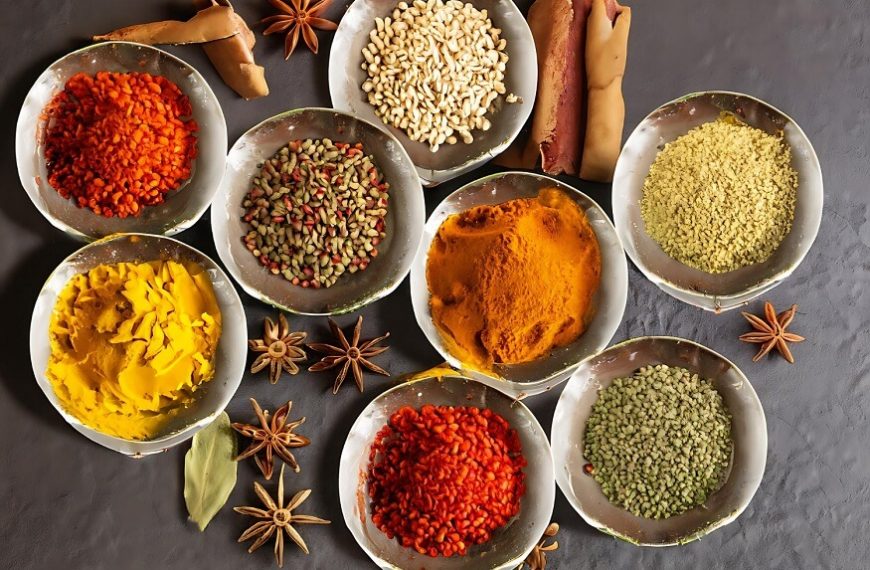‘Fancy a good Curry?’ That’s a phrase you’ll probably hear more often, in countries other than India!
What we call Curry Powder, is nothing short of a heady mix of some fine Indian spices. Spices like Coriander, Cumin and Fenugreek, that are commonly used in most Indian recipes.
From time immemorial, different cultures around the world have been portrayed by the culinary choices of its inhabitants. To truly imbibe Indian culture, is to unlock the secrets of Indian Spices.
Are you ready to find out all about Indian Spices, and their magical contribution to a cuisine that is heralded far and wide for its uniqueness? Time to decode those Indian recipes, and shed some light on the Secret Spices that lay the cornerstone of their foundation!
The Secrets of Indian Spices
They say, ‘Variety is the Spice of Life.’ It’s even better, when the focus of the word ‘Variety’, is nothing other than ‘Spice’ itself!
When one thinks of Indian Spices, one thinks of an explosion of Flavours and Colours. From Paprika to Pepper, you can easily add a new dimension to your cooking repertoire, through the use of some good old Indian Spices.
Perhaps the Secrets of Indian Spices lie in their sheer Variety. Did you know that many Secret Spices like Stone Flower, are obscure and only used in certain regions of our country? Nevertheless, the act of combining any of these myriad Indian Spices to produce a beautiful dish, is near sublime.
Are your taste buds tingling, in anticipation of the spices you are going to add to your food after reading this article? Read on, to find out more about Indian spices, and how they can be used to ‘Spice things up’ in the kitchen!
Top Indian Spices: Essentials for Fine Indian Cooking
Time to get familiar with the top spices used in Indian households. You’ve probably tasted them all, without even knowing what they are. If there’s ever a time to find out what makes most dishes you eat so special, it is now!
Turmeric (Haldi)
This Ground Spice has an earthy flavour. It is most commonly distinguished by its astonishing yellow colour. Health Benefits: It is a potent anti-inflammatory and antioxidant. Note: When using turmeric for health benefits, you must combine it with black pepper, for added effect.
Cumin Seeds
This is a Spice that has been around since The Middle Ages! Forming the basis of many traditional Indian dishes, it is cultivated mainly in India, Turkey and China.
Health Benefits: It is used to soothe digestive disorders.
Garam Masala
The very name of this Spice, is enough to get one’s mouth watering! India’s most famous seasoning, this one is a combination of dry spices that include Pepper, Cinnamon and Nutmeg. If you ever wondered where the ‘Zing’ in that dish of Chana Masala came from, it’s from this one.
Health Benefits: Besides aiding digestion, Garam Masala is known to improve immunity.
Coriander
Interestingly, this aromatic Indian Spice is from the same family as Cumin Seeds. Coriander seeds are sometimes ground and used in powder, to flavour meats and bread.
Health Benefits: Apart from facilitating digestion, it helps fight insomnia.
Green Cardamom (Green Elaichi)
There’s just no mistaking the flavour of this delectable spice, that, quite interestingly, tastes a lot like Eucalyptus. It is typically fried in hot oil, at the beginning of cooking an Indian dish.
Health Benefits: It can ease inflammation and help your body handle insulin better.
Chilli Pepper
Ever wondered where all that ‘Spiciness’ in Indian cooking comes from? It’s from Chilli! Health benefits: It may delay age-related memory loss, and have blood sugar lowering effects. Interesting fact: In hot countries, eating chili pepper helps to cut thirst, and to keep water in the body. Now you know why Indians eat so much chilli!
Secret Spices: Uncommon Indian Spices
The following are some lesser known Indian Spices, that are no less ‘potent’ when it comes to helping curate a mouth-watering recipe!
Anardana (Dried Pomegranate Seeds)
When you think of Anardana, you think of a melange of Sweet, Fruity and Tangy tones. Popular in North India, it is also used as a preservative to make chutneys and pickles.
Kalonji (Nigella Seeds)
If you’ve ever wondered what those black seeds on your naan bread might be, it is these. Also known as Nigella Seeds, they have a faintly bitter taste, with a hint of sweetness. This one’s a great spice that is used to flavour a vast array of Indian dishes, including pickles.
Kalpasi
This ‘lichen’ with a slightly woody scent, is most commonly found in Chettinad and Maharashtrian cuisines.
Interesting Fact: Quite mysteriously, Kalpasi has no taste of its own, but adds a unique flavour to whatever food it is added to!
Kokum
This one’s actually a fruit, but it is used as a spice in Konkan regions. Found mostly in Maharashtra, Goa and Karnataka, it lends its tangy and tasty flavours to the cuisine it is added to. Kokum Masala is made from the fruit’s peel, which is dried, salted and then ground to make the Kokum Powder.
Radhuni
This is the dried fruit of Wild Celery. Interestingly, while it tastes much like Celery, it smells like Parsley! Often confused with Ajwain Seeds on account of its similar appearance, it is a vital component of the Bengali five-spice mix, Paanch Phoran.
Jaiur
People are undoubtedly more familiar with the more common name of this distinctly flavoured Meghalaya spice. Namely, ‘Szechuan Pepper!’ Not particularly pungent on its own, it has slightly lemony overtones, and prepares the palate for hot spices. The tiny seed pods of Jaiur are toasted, before being crushed and used in chutneys.
At EuroKids, we believe that it is important to teach your little ones about the Spices that form part of their country’s rich heritage. Furthermore, we encourage you to have your children indulge in eating foods that are laced with Spices. After all, not only do Spices flavour food, they help keep infections well at bay, too.
















